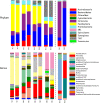High throughput DNA sequencing to detect differences in the subgingival plaque microbiome in elderly subjects with and without dementia
- PMID: 22998923
- PMCID: PMC3488532
- DOI: 10.1186/2041-2223-3-19
High throughput DNA sequencing to detect differences in the subgingival plaque microbiome in elderly subjects with and without dementia
Abstract
Background: To investigate the potential association between oral health and cognitive function, a pilot study was conducted to evaluate high throughput DNA sequencing of the V3 region of the 16S ribosomal RNA gene for determining the relative abundance of bacterial taxa in subgingival plaque from older adults with or without dementia.
Methods: Subgingival plaque samples were obtained from ten individuals at least 70 years old who participated in a study to assess oral health and cognitive function. DNA was isolated from the samples and a gene segment from the V3 portion of the 16S bacterial ribosomal RNA gene was amplified and sequenced using an Illumina HiSeq1000 DNA sequencer. Bacterial populations found in the subgingival plaque were identified and assessed with respect to the cognitive status and oral health of the participants who provided the samples.
Results: More than two million high quality DNA sequences were obtained from each sample. Individuals differed greatly in the mix of phylotypes, but different sites from different subgingival depths in the same subject were usually similar. No consistent differences were observed in this small sample between subjects separated by levels of oral health, sex, or age; however a consistently higher level of Fusobacteriaceae and a generally lower level of Prevotellaceae was seen in subjects without dementia, although the difference did not reach statistical significance, possibly because of the small sample size.
Conclusions: The results from this pilot study provide suggestive evidence that alterations in the subgingival microbiome are associated with changes in cognitive function, and provide support for an expanded analysis of the role of the oral microbiome in dementia.
Figures





Similar articles
-
The Subgingival Microbiome of Periodontal Pockets With Different Probing Depths in Chronic and Aggressive Periodontitis: A Pilot Study.Front Cell Infect Microbiol. 2018 May 1;8:124. doi: 10.3389/fcimb.2018.00124. eCollection 2018. Front Cell Infect Microbiol. 2018. PMID: 29765908 Free PMC article.
-
Metagenomic analysis of subgingival microbiota following non-surgical periodontal therapy: a pilot study.Open Dent J. 2012;6:255-61. doi: 10.2174/1874210601206010255. Epub 2012 Dec 28. Open Dent J. 2012. PMID: 23341849 Free PMC article.
-
Comparison of Subgingival and Buccal Mucosa Microbiome in Chronic and Aggressive Periodontitis: A Pilot Study.Front Cell Infect Microbiol. 2019 Mar 11;9:53. doi: 10.3389/fcimb.2019.00053. eCollection 2019. Front Cell Infect Microbiol. 2019. PMID: 30915280 Free PMC article.
-
Distinctive subgingival microbial signatures in older adults with different levels of cognitive function.J Clin Periodontol. 2024 Aug;51(8):1066-1080. doi: 10.1111/jcpe.13997. Epub 2024 May 20. J Clin Periodontol. 2024. PMID: 38769711
-
Subgingival microbiome of deep and shallow periodontal sites in patients with rheumatoid arthritis: a pilot study.BMC Oral Health. 2021 May 8;21(1):248. doi: 10.1186/s12903-021-01597-x. BMC Oral Health. 2021. PMID: 33964928 Free PMC article.
Cited by
-
The subgingival periodontal microbiota of the aging mouth.Periodontol 2000. 2016 Oct;72(1):30-53. doi: 10.1111/prd.12136. Periodontol 2000. 2016. PMID: 27501490 Free PMC article. Review.
-
Proteomic analysis of saliva in HIV-positive heroin addicts reveals proteins correlated with cognition.PLoS One. 2014 Apr 9;9(4):e89366. doi: 10.1371/journal.pone.0089366. eCollection 2014. PLoS One. 2014. PMID: 24717448 Free PMC article.
-
Oral Microbiota Changes in Elderly Patients, an Indicator of Alzheimer's Disease.Int J Environ Res Public Health. 2021 Apr 15;18(8):4211. doi: 10.3390/ijerph18084211. Int J Environ Res Public Health. 2021. PMID: 33921182 Free PMC article.
-
Dysregulation of Porphyromonas gingivalis Agmatine Deiminase Expression in Alzheimer's Disease.Curr Alzheimer Res. 2024;21(4):232-241. doi: 10.2174/0115672050327009240808103542. Curr Alzheimer Res. 2024. PMID: 39143870
-
Microbiome alterations are associated with apolipoprotein E mutation in Octodon degus and humans with Alzheimer's disease.iScience. 2024 Jun 22;27(8):110348. doi: 10.1016/j.isci.2024.110348. eCollection 2024 Aug 16. iScience. 2024. PMID: 39148714 Free PMC article.
References
-
- Kamer AR, Dasanayake AP, Craig RG, Glodzik-Sobanska L, Bry M, Leon MJ. Alzheimer's disease and peripheral infections: the possible contribution from periodontal infections, model and hypothesis. J Alzheimers Dis. 2008;13:437–449. - PubMed
LinkOut - more resources
Full Text Sources
Other Literature Sources
Medical

